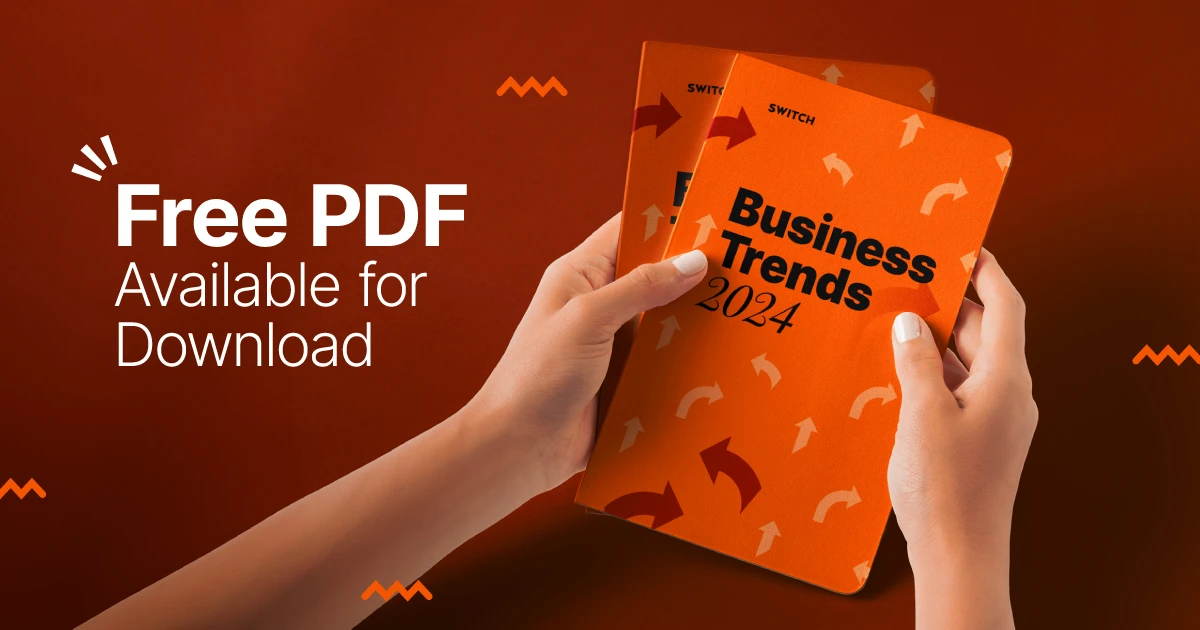Get a designed PDF copy of Business Trends for 2024
Fair warning, this is a relatively long read. If you don’t have the time to take it all in now, you can download the PDF version of Business Trends for 2024 for free by clicking below. Otherwise, just keep reading!

Businesses have a lot to combat in 2024.
The U.S. election cycle. Ongoing unrest in the world. Stricter climate measures shepherded by world governments. Shrinking talent pools and competition for limited resources. A heap of new technologies and subscription services that will provide ever growing amounts of data.
We’ve already spoken a little about consumer trends, the backbone of trendwatching itself.
Businesses are no different from consumers here. They are equally impacted by current affairs, and they should adapt to the changes that are coming their way. Consumers are a ruling class.
Businesses are what they rule. One feeds into the other.
2024 business trends can carry on from where we left off. Consumers want personality, immersion, and quality in their services.
Businesses need simpler data, upskilled employees, and go-to-ground strategies to deliver those promises.

A snapshot of 2023
The pandemic might be over, but the fallout across industries is still a key concern. Manufacturing, shipping logistics, and the price of goods have remained higher than pre-pandemic levels, and it is likely that we won’t see a downturn as limited resources continue to make production difficult.
But beyond the issue of deliveries, there is an issue of capacities. Burnout is on the rise, with 42% of businesses reporting burnout in their workforces. A shrinking talent pool has made it difficult to fulfill some of the legacy roles that have built modern business, such as lead IT and development. The creation of new automated technologies and business intelligence software has also led to the creation of increasingly niche jobs, many of which have limited experts available, and where training may take years to produce employees of that same calibre.
And while AI has definitely increased the productivity of companies, it is also significantly increasing the operational costs of businesses who are opting into the strategic advantage of AI as they pay for access to those AI models.

2024: the year of simple data, employee prioritisation, and strategy
The biggest driver for 2024 is AI.
How AI can increase productivity. How AI can help you brainstorm ideas. How AI can pull your human employees away from tasks that are time-consuming and repetitive, better left to a computer. How AI can help enhance the creative you put out.
AI is a tool that consumers can have diverging opinions on. AI is a tool that consumers can opt out of.
For businesses, it is a necessary asset. There is no future for businesses that opt out of using AI: every industry has been redefined in the last handful of years to require it.
But AI used for AI’s sake is not going to help.
In 2024, AI in business means simplifying the data you work with. It means prioritising the roles your human employees play in your organisation. It means developing a strategy that balances resilience, sustainability, and innovation.
Here’s what that looks like.

A note on trendwatching
Trends exist because consumers exist. Your business exists because you have consumers who make purchases – and those consumers will change their minds as the circumstances surrounding their lives change.
To understand where trends are coming from means you understand your audience, and that means your business always has its finger right on the pulse of what will work.
Do businesses need trendwatching?
Every business benefits from trendwatching. Consumers are influenced by the environments in which they live and survive in, and with the way the world is changing, brands have become a way for these customers to showcase what side of history they are on. They use brands as an extension of their value, their personality, their beliefs; they use brands to communicate with other, like-minded people who also use those brands.
And every business around the world is potentially tied to one of these expressions. Trendwatching means that you are always on the right side of what your audience wants to see.

Trend 1: Data downscale
- From 2023 to 2025, data will balloon from 120 zettabytes to 181 zettabytes of information.
- 30% of businesses are overwhelmed by the sheer amount of data.
- 90% of generated data is unstructured.
Businesses need data to function.
But simply having that data isn’t enough. Most businesses have more data than they actually need, and no idea what to do with it. Every day, we add more data to the pile, so businesses need to parse through their numbers much faster than they used to.
Turning that data from numbers and statistics into usable information about their audiences is a job for that self-same AI.
They need to know which of their products is exceeding their expectations, which of their services has started to dip in efficacy, and what their customers are spending the most time on.
When social media was still a major change to the business landscape, that data came in dribbles.
This is no longer the case.
Businesses in 2024 have too much data to keep track of – and most of the data that is generated and given to businesses today doesn’t fall into neat categories that businesses can look over at their leisure. The rate and speed at which businesses obtain data has become unmanageable and an area that is actively losing businesses profit that they could be making.
For 2024, AI-led data summaries will become crucial for businesses to start cutting through to the heart of the data that matters to them. AI trained to summarise and produce insights off given BI datasets is going to be a wise investment for organisations in 2024, and will become an essential tool for organisations by the end of the year.

How does this trend benefit bigger businesses?
Businesses generate data from an enormous number of collection points: transaction rates, digital touchpoints, physical retail, socials, campaigns… – and bigger businesses may have more data to contend with than those that are still in the start-up phase. If it hasn’t happened already, these organisations are already inundated with too much data for them to make meaningful, impactful decisions, and it’s far past the time when an investment in data management should be made.
How does this trend benefit smaller businesses?
Setting up your smaller business with the capacity to both handle big quantities of data and generate decisive summaries of that data means the path going forward is much smoother in the long run. As these businesses continue to grow and generate more data than they need, AI-powered analysis can help set them up to only draw the relevant information out of a sea of content.

Trend 2: Employee initiative extensions
- 44% of employee skills will see disruption in the next 5 years.
- 73% of businesses consider most employees to require reskilling due to AI.
- 1 in 16 employees may have to switch jobs as a result of changing work habits.
Employees determine the success of your business.
They are also vastly underprepared for the years that are to come.
Employees in 2024 are facing an unmitigated change in their working environment, one that will force them to change the way they work the same way Gmail and Google Drive and Slack did. With every business diving feet-first into AI to try and streamline processes, employees face a reckoning to develop a skillset for a tool that is in its infancy, and won’t see the end of its early development cycle without drastic change.
And beyond the necessary need to upskill, there is the additional concern that many employees are facing: Where will they fit into work if AI is coming for their careers?
For 2024, businesses need to invest in their employees: in upskilling them to prepare them for the year to come, in making sure that there is continuous development to address concerns, and in giving their employees a reason to remain with the business.

How does this trend benefit bigger businesses?
Your biggest asset is always going to be your employees. For larger businesses, investing in your employees now means that the risks of them leaving to find jobs in other sectors is minimised. Retaining employees and upskilling them rather than hiring for new positions is fundamentally better: both from an economical perspective as well as a company culture one.
How does this trend benefit smaller businesses?
Hiring new employees is expensive. Smaller businesses who are operating on smaller profit margins than larger organisations will struggle to maintain profits if they’re continuously looking outwards to fulfill new roles – and with the shift into new operations affecting every organisation regardless of size, upskilling employees becomes a necessary lifeline for smaller businesses.

Trend 3: Strategising for sustainability
- 75% of CxOs have increased their sustainability investments.
- 82% of consumers will only buy from companies who match their values.
- 60% of consumer purchasing behaviour is tied to the ethical and environmental aspects of a business, and this increases by 10% YOY.
If sustainability wasn’t a business concern up until now, it’s going to become one in 2024. Consumers are increasingly driven by their values, and paying far greater attention to what a company does – or does not – do. Boycotts, which have historically proven to be one of the less effective methods, have started to gain efficacy as consumers refuse to populate businesses which no longer share their values or act in a way they don’t like. We’ve seen threads of this in previous years, but it is becoming a matter that businesses can no longer put off.
And it involves a lot more than just green initiatives.
Businesses will get no more second chances from here on out. They are communicating with a population that is disaffected by its experiences, and has determined that there must be a line drawn somewhere. For most businesses, that line exists in black and white, and they will fall on one side or the other depending on consumers’ personal preferences.
Sustainability in 2024 is resilience. It’s staying afloat in the face of both the internal – remote working, employee talent shrinkage – and the external factors. It’s realising that businesses, now more than ever, have become a language to the people they service – and it’s realising that, to remain on the right side of that language, they have to pivot, over and over again.

Data. Skills. Sustainability.
Businesses who want to move forward in 2024 will not find these trends surprising – but the speed at which these factors have developed is leaving very little room for error.
But there’s hope, still. Businesses can find their way back to what they set out to achieve, find a purpose that fits them, find values that they want to champion. Where all the other work is external, 2024 will have businesses focusing internally, on what they can do with resources they already own or resources they should have in play.
And if they’re not quite sure what those resources are, there’s companies that can help them figure it out.
We’ve published these trend reports for years. And we’re always willing to help – just drop us a line!





